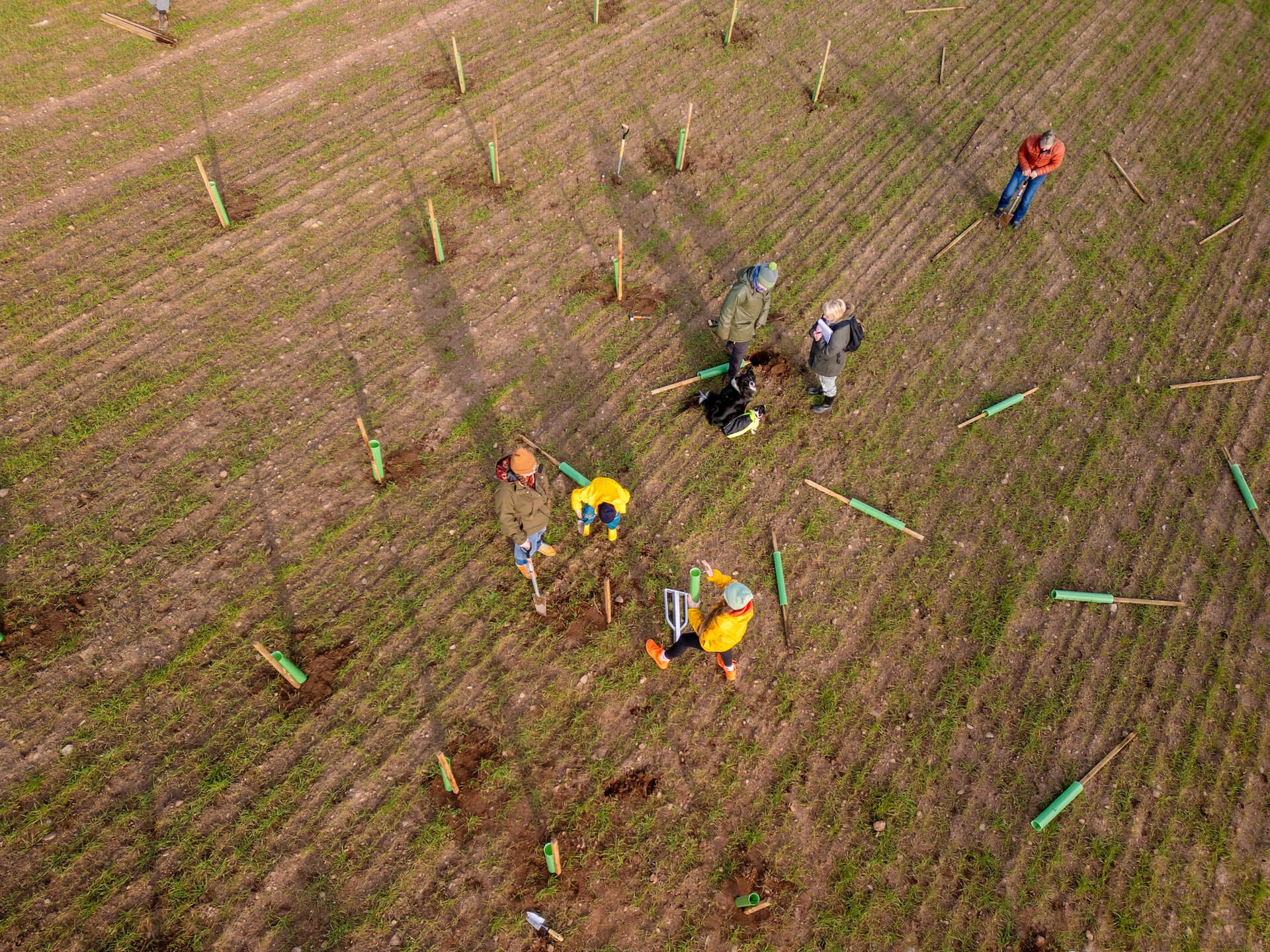Forest Plan / Context / National Policy Context

National Policy Context
England’s Community Forests create sustainable woodlands which are multifunctional: for climate, public health, green infrastructure and more. Community Forests’ activities enhance people’s lives and livelihoods, help nature to thrive and tackle the climate emergency.
This section highlights key aspects of national policy and legislation which England’s Community Forests respond to and deliver against[G]. These are summarised in Figure 5 with further details below.
[G] National policy context as at time of drafting (February 2025).
Figure 5: Summary of relevant national policy and legislation
Land use
UK Forestry Standard (Forestry Commission, 2024)
National Planning Policy Framework (DLUHC, 2024) and Guidance (2023)
Green Infrastructure Framework (Natural England, 2023)
Multifunctional Land Use Framework and consultation (in development)
Protected Landscapes Targets & Outcomes Frameworks (Defra, 2024)
Land use
The UK Forestry Standard 2024 (Forestry Commission) or UKFS, defines the government approach to sustainable forestry and is applied to all woodland creation and management across the UK. It provides requirements and guidelines for sustainable forestry in terms of its contributions to biodiversity, climate, heritage, landscape, people, soil and water. The UKFS also sets out a basis for regulation and monitoring of these standards. Community Forests use the UKFS to ensure their woodland creation and Forest Plans meet legal requirements and wherever possible best practice requirements, such as community involvement in the planning process.
Responding to the Levelling up and Regeneration Act 2023, the National Planning Policy Framework 2024 (DLUHC [H]) reflects government targets and influences all local planning documents in England. It states that “Community Forests offer valuable opportunities for improving the environment around towns and cities, by upgrading the landscape and providing for recreation and wildlife… an approved Community Forest Plan may be a material consideration in preparing development plans and in deciding planning applications” (paragraph 152, p. 44).
The supporting National Planning Practice Guidance 2023 for the Natural environment (2019) states that:
“Community Forests are designed to bring the benefits of multi-purpose trees, woodland and forestry close to where people live. Within these areas developments are expected to include appropriate green infrastructure, in accordance with […] an approved Community Forest Plan. Planning policies and decisions need to consider the extent and type of woodland planting necessary to ensure that the new development will contribute to the creation and emerging character of the Forests.” (paragraph 30).
The Green Infrastructure Framework 2023 (Natural England) is a commitment from the 25 Year Environment Plan. It supports urban greening and connection with the surrounding landscape to bring benefits for nature, climate, health and prosperity. It sets out principles, standards (including S5: Urban Tree Canopy Cover), guides and ‘process journeys’ [12] to help embed Green Infrastructure-informed decision-making into and between organisations. Community Forests provide green infrastructure, which supports regional growth. Their Forest plans support planning and regeneration strategies of local authorities, by targeting activities in areas of socio-economic disadvantage and low woodland cover. [13]
The Food, Farming and Countryside Commission are trialling a Multifunctional Land Use Framework which they have developed to support land management for multiple benefits. The framework will help to address the many demands placed on land through government targets whilst optimising delivery of social, economic and environmental objectives. At the time of writing, the Government has opened a public consultation on managing land use change in England [14]. The outcomes are likely to provide important context for the delivery of the Cumbria Community Forest Plan.
The Protected Landscapes Targets and Outcomes Framework 2024 (Defra) promotes actions to achieve positive changes for environment, climate, heritage and people-nature connection within the Protected Landscapes of England. Target 8 aims to: “Increase tree canopy and woodland cover (combined) by 3% of total land area in Protected Landscapes by 2050 (from 2022 baseline)”. Several Community Forests in England share their forest area with Protected Landscapes, and this framework provides both opportunities and challenges for woodland establishment.
[H] Department for Levelling Up, Housing and Communities

Biodiversity & environmental protection
The Environment Act 2021 is government legislation to improve air and water quality, tackle waste, increase recycling, halt the decline of species, and improve our natural environment. It sets 13 environmental targets, including to increase “tree and woodland cover to 16.5% of total land area in England by 2050”. It also aims to “Halt the decline in species populations by 2030, and then increase populations by at least 10% to exceed current levels by 2042”, requiring local authorities to develop Local Nature Recovery Strategies (LNRS) and providing the mandate for developments to achieve at least 10% Biodiversity Net Gain. Each of England’s Community Forests are working to ensure that their Forest Plans and relevant LNRS align, support, and strengthen each other, and provide routes to achieving Biodiversity Net Gain through habitat creation and maintenance.
The 25 year Environment Plan 2018 (Defra [I]) sets goals for improving the environment within a generation. Its implementation is guided by the Environment Act 2021 aims and targets, and it uses the Natural Capital Framework to frame goals for the next 25 years. It reiterates Government support for Community Forests “so that they can [continue to] play a leading role in urban tree planting”, create and improve green infrastructure in towns and cities across England (p. 48), and connect young people with nature (p. 76).
The Environmental Improvement Plan 2023 (Defra) is the first revision of the 25 Year Environment Plan. It sets out the target to: “Increase tree canopy and woodland cover from 14.5% to 16.5% of total land area in England by 2050, with a new interim target to increase this by 0.26% (equivalent to 34,000 hectares) by 31 January 2028, in line with the trajectory required to achieve the long-term target”.
The England Trees Action Plan 2021-2024 (Defra) [J] outlines the Government’s vision for our treescape in 2050 and beyond, and provides a strategic framework for implementing the Nature for Climate Fund. The plan supports tree establishment through Trees for Climate funding, provided to England’s Community Forests to create new woodland which is “planted and managed by, and for the benefit of, local communities, based on long-established Forest Plans, recognised by our National Planning Policy Framework” (p. 31).
[I] Department for Environment, Food and Rural Affairs
[J] This policy is included as the most recent relevant policy at time of writing.

Climate
The Climate Change Act 2008 (revised 2019) sets a legally binding target for the UK to reduce greenhouse gas emissions to ‘net zero’ by 2050. It requires the Government to regularly assess risks of climate change to the UK and set objectives to adapt to these changes. It gave rise to the Nature for Climate Fund and Programme, and subsequent Trees for Climate funding, supporting action to deliver against these objectives.
The Net Zero Strategy 2021 (DESNZ & BEIS)[K] is a long-term plan for a transition over the next three decades to achieve net zero by 2050. A key commitment was to treble woodland creation rates from 2021 to meet the overall UK target of 30,000 hectares of woodland established annually by 2025, with England contributing 7500 hectares annually to this target. England’s Community Forests are a key national delivery partner for this target, contributing 35% of all Government funded trees established in England since 2020 [15].
The Sustainability and Climate Change Strategy 2022 (Department for Education) sets out the vision for the UK to be the world-leading education sector in sustainability and climate change by 2030. This involves climate change education and fostering a greater connection to nature, which Community Forests support through their work across England.
[K] Department for Energy Security & Net Zero, and (the former) Department for Business, Energy & Industrial Strategy

Water
The Plan for Water 2023 (Defra) aims to deliver clean and plentiful water, a healthy water environment, and a sustainable supply of water for all. In support of these aims, the plan encourages tree planting along rivers through Government-funded woodland creation schemes and the Woodland Water Code, which enables private investment into woodland creation. The ‘Woodlands for Water’ 4-year programme supported these aims as well as partnerships with Water Companies to exceed the water industry target of planting 11 million trees by 2030.
The National Flood and Coastal Erosion Risk Management Strategy for England 2020 (Environment Agency) describes what needs to be done by all risk management authorities involved in flood and coastal erosion risk management for the benefit of people and places. The strategy acknowledges tree planting as an effective nature-based solution for flooding, coastal erosion and carbon storage, alongside the restoration of wetlands.
Community Forests can participate in groups such as catchment partnerships alongside other local organisations to support the aims of these strategies.
Public health
The Woodland Access Implementation Plan 2023 (Defra) commits to ensuring that safe and appropriate public access is a feature of as many woodlands as possible, supporting new woodland creation and the protection of existing woodlands. Community Forests are acknowledged for their delivery of the Trees for Climate programme, which has increased the number of people living within 500 metres of a woodland by over half a million across England [16].
The UK adopted the United Nations Sustainable Development Goals (SDGs) in 2015, committing to 17 goals which aim to: “end poverty, protect the planet and improve the lives and prospects of everyone, everywhere”. These global goals influence England’s national policy context and England’s Community Forests deliver on many of these goals. For example, SDG 3 Good Health and Wellbeing; SDG 8 Decent Work and Economic Growth; SDG 10 Reduced Inequalities; SDG 11 Sustainable Cities and Communities; SDG 13 Climate Action; and SDG 15 Life on Land.
Employment and economy
The Agricultural Transition Plan 2021-2024 (Defra) [L] aims to renew the agricultural sector and encourages changes towards sustainable farming practices which contribute to national environmental goals. It supports diversification strategies such as tree and woodland management, restoring habitats and woodland creation (p. 33) and encourages farmers to apply for the appropriate agri-environment and forestry agreements. Community Forests across England are diverse and span both urban and rural settings, and farming communities are a key part of our community landscape.
The National Wood Strategy 2023 (Barnes and Leitch) describes how England’s wood-based industries can increase the growing, harvesting and production of timber. Developed in collaboration with government, non-governmental organisations and professional membership organisations, it sets out six strategic goals including increasing the use and lifespan of English wood and developing a skilled workforce. Community Forests can support the realisation of this strategy through their woodland creation programmes and activities.
[L] This policy is included as the most recent relevant policy at time of writing.

[12] Natural England (2025) GI Process Journeys. Available at: https://designatedsites.naturalengland.org.uk/GreenInfrastructure/ProcessJourneys.aspx#:~:text=All%20the%20process%20journeys%20advocate%20involving%20a%20wide,development%20and%20improved%20management%20of%20existing%20Green%20Infrastructure.
[13] Department for Environment, Food & Rural Affairs, Environment Agency and Lord Goldsmith (2022) Major expansion of woodlands for communities across England. Press Release. Available at: https://www.gov.uk/government/news/major-expansion-of-woodlands-for-communities-across-england
[14] Department for Environment, Food & Rural Affairs and Rt Hon Steve Reed OBE MP. Land use in England. Open consultation. Available at: https://www.gov.uk/government/consultations/land-use-in-england
[15] England’s Community Forests (2024) Trees for Climate Impact Report: Year 4, 2023-24. Available at: https://englandscommunityforests.org.uk/wp-content/uploads/2024/09/ecf-tfc-impactreport-year4-202324.pdf
[16] England’s Community Forests (2023) Trees for Climate 2022-2023 – Impact & Achievements. Available at: https://englandscommunityforests.org.uk/wp-content/uploads/2023/10/900_ECF_Climate-for-Trees_2023_annual_report_Dr4_MW-1.pdf

